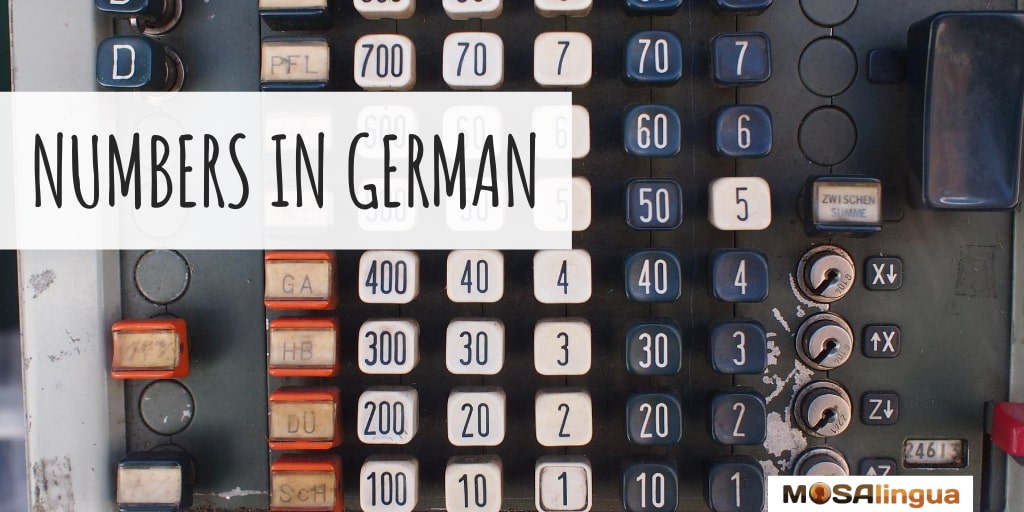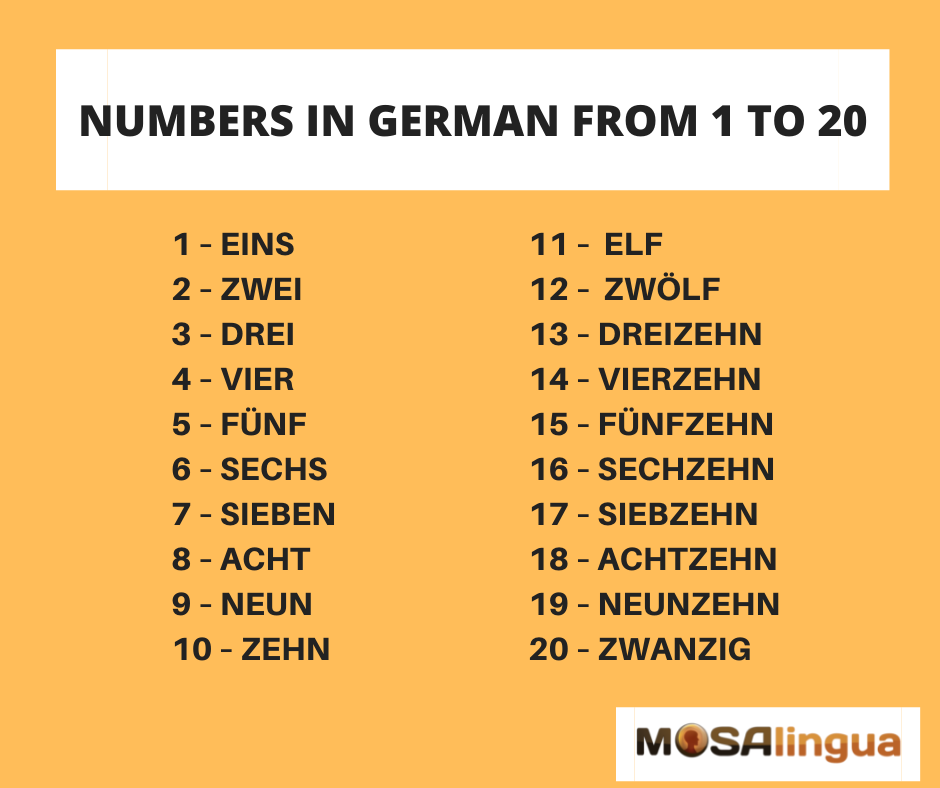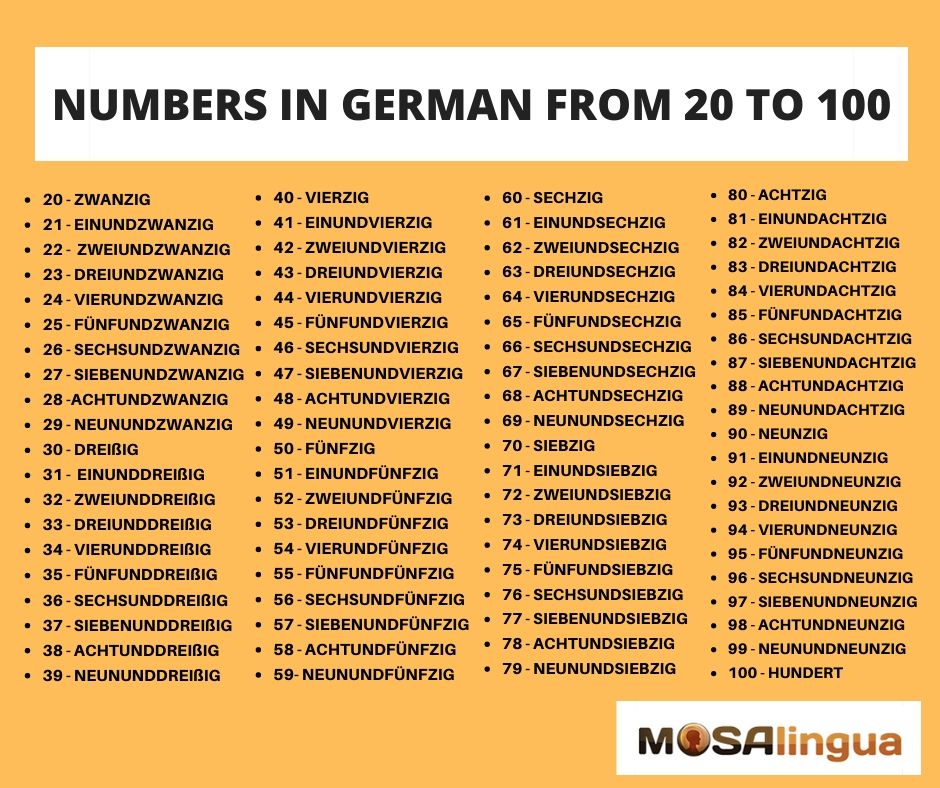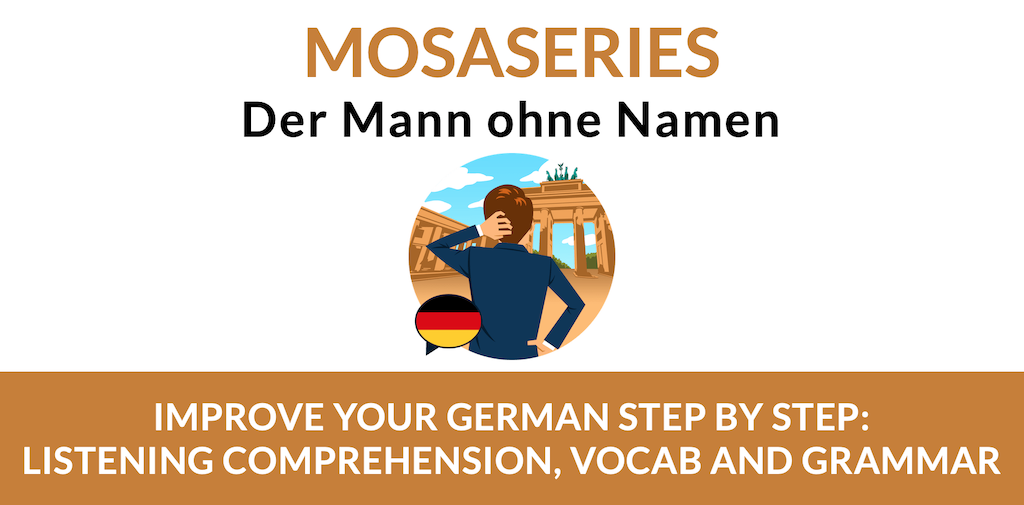The German language is known for being pretty complicated… so if you just started studying it, don’t get discouraged! Learning the numbers of a language is an important step to being able to use it in everyday life. And thankfully, as far as German vocabulary goes, numbers aren’t all that complicated. Keep reading this article to find out how to say the numbers in German and how to use them in different situations.

What’s inside…
All About German Numbers
The cardinal numbers: 1 to 20 in German
Learning the numbers in German comes down to memorization, especially for numbers 1 through 20. But learning basic aspects of German vocabulary like this one is vital if you want to learn German fast. If you struggle with memorizing words, we recommend reading our article on how to learn vocabulary. And once you know these well enough, bigger numbers are quite easy because they follow a logical pattern.
- Like in English, numbers 1 through 12 have their own special names.
- After that, we create new numbers by adding “ten”: drei (3) + zehn (10) = 13 (dreizehn or thirteen).
- All numbers up to one million are written as one word, without hyphens or spaces.
(Feel free to download these German number cheat sheets! Right-click on the image to save it to your computer, or press down on and hold it to save it to a mobile device.)
If you’re a fan of electronic music, you can memorize these numbers super quickly with a remix of… a classic nursery rhyme. The German group Mo-Do created an incredibly popular techno version of the children’s song “Eins, Zwei, Polizei” in 1995. Check it out:
Lyrics:
“Eins, zwei, Polizei
Drei, vier, Grenadier
Fünf, sechs, alte Hex’
Sieben, acht – gute Nacht!”
It’s so catchy that you can’t help but memorize the lyrics—it’s a great way to learn to count to 10 in German! Plus, rhyme is an effective technique for remembering correct German pronunciation. If you’re interested in learning a language with music, here’s another article we think you’ll like.
German numbers from 20 to 100
- Multiples of tens are formed by putting together the original number and -zig. For example, 30 is dreißig, 40 is vierzig, 50 is fünzig, etc. The only exception is 20, which is irregular, zwanzig.
- When adding the unit and multiple of ten, we use the word und (meaning and): einundzwanzig (21, or “one and twenty”), dreiundsechzig (63, or “three and sixty”). So the formula is: unit + und + tens. Easy!
- In English, for numbers 20 and above, we put the multiple of ten before the unit: twenty one, thirty two, fourty nine. In German, it always stays at the end: einundvierzig (41), zweiundsechzig (62), neunundachtzig (89)
Ordinal numbers
Ordinal numbers indicate order, as their name implies (first, second, third, etc.). Here it’s worth mentioning a couple of things regarding the formation of ordinal numbers:
- For 2nd, and from 4th to 19th, add the ending “-te” to the cardinal number. So you get zweite (second), vierte (fourth), fünfte (fifth), and so on.
- For numbers 20th to 1 millionth, you add the ending “-ste” to the cardinal number: vierundzwanzigste (twenty-fourth, 24th), dreiundvierzigste (forty-third, 43rd).
- Ordinal numbers 1st and 3rd are irregular: erste (first) and dritte (third).
Prices in German
Here’s how to write and say prices in German:
0,05 € –> fünf Cent
2 € –> zwei Euro
2,10 € –> zwei Euro zehn (Cent)
Start improving your German today
Good news: we can help!
More good news: you can get started for free! With your free trial, you can test drive the most effective method for learning German for the next 15 days!
Vocabulary flashcards, videos with subtitles, audiobooks, articles adapted to your level – with MosaLingua Premium (Web & Mobile), you’ll have access to all this and more. Get started right now. It’s free—and risk-free—to try!
How to Say German Numbers
When you see German numbers written out in words, it’s not always easy to figure out how to pronounce them. Thankfully, when you learn numbers in German with your MosaLingua Learn German app, you’ll benefit from pronunciation by native speakers for every flashcard. But if you want to hear how to pronounce German numbers on the fly, listen up:
| German Number | Pronunciation | IPA Transcription | German Number | Pronunciation | IPA Transcription |
|---|---|---|---|---|---|
| (1) eins | [ˈains] | (11) elf | [ɛlf] | ||
| (2) zwei | [tsvai] | (12) zwölf | [tsvœlf] | ||
| (3) drei | [drai] | (13) dreizehn | [ˈdraitse:n] | ||
| (4) vier | [fi:ɐ̯] | (14) vierzehn | [ˈfɪrtse:n] | ||
| (5) fünf | [fʏnf] | (15) fünfzehn | [ˈfʏnftse:n] | ||
| (6) sechs | [zɛks] | (16) sechzehn | [ˈzɛçtse:n] | ||
| (7) sieben | [ˈzi:bn̩] | (17) siebzehn | [ˈzi:ptse:n] | ||
| (8) acht | [axt] | (18) achtzehn | [ˈaxtse:n] | ||
| (9) neun | [nɔyn] | (19) neunzehn | [ˈnɔyntse:n] | ||
| (10) zehn | [tse:n] | (20) zwanzig | [ˈtsvantsɪç] |
(Note: If some sounds appear to be unavailable, try refreshing the page. If they are still not available, we’d appreciate it if you left us a comment to let us know!)
Now you know how to count to 20 in German! Ready for something a little more complex?
Advanced Numbers in German: Declensions in Cardinal Numbers
If you study German, I’m sure you’re familiar with declensions. But, what are declensions really? Declension is a way of showing the role of a noun (or adjective, article, etc.) in a sentence. That is, the ending of the word changes based on whether it’s the subject, a direct or indirect object, etc.
German rules dictate that, whenever possible, the case, number, and gender of a noun must be indicated with a declension.
Because numbers are nouns, they also have declensions. But don’t worry! That’s not the case for all numbers. In fact, only numbers 1, 2, and 3 have declensions. Let’s see how it works:
Declensions of 1 (eins)
- If the number 1 is not followed by a noun, then it doesn’t need a declension and we always say “eins”:
Formel eins = Formula one (in this case the noun goes first)
- If the number 1 is followed by a noun, we normally use the weak declension, which equals the indefinite (a, an) article:
Ich habe eine Lampe = I have a lamp
| Masculine | Feminine | Neutral | Plural | |
|---|---|---|---|---|
| Nominative | ein | eine | ein | -- |
| Accusative | einen | eine | ein | -- |
| Dative | einem | einer | einem | -- |
| Genitive | eines | einer | eines | -- |
Declensions for 2 and 3
- If 2 and 3 are not followed by a noun, they don’t need a declension, so it’s always zwei and drei.
- If 2 and 3 are followed by a noun, they only need the declension in the Genitiv when not preceded by an article. The ending in Genitiv is -er: zweier, dreier, e.g. Er hat das Einverständnis zweier Mitarbeiter. We can eliminate the use of Genitiv using the preposition “von” – in the first example we could simply say: Er hat das Einverständnis von zwei Mitarbeitern. The cardinal number remains unchanged and only the object (that is now in Dativ because of the preposition “von”) needs a declension and becomes “Mitarbeitern“. In case this seems easier to you. Also, German speakers generally don’t use Genitiv when they don’t have to 😉
Learn More German Numbers and Other Vocab
Here are a couple of articles on other German vocab you should know:
- Essential phrases: How to Say Hello, Thank You and Sorry in German
- Informal language: German Slang Words to Sound Like A Native Speaker [VIDEO]
- Tools for learning vocab and practicing other skills:
If all that stuff about declension and articles had your head spinning, you may also want to check out our German grammar guide. We’ve put together a guide to different topics in German grammar (we add to it frequently!), explained in a user-friendly way.
Finally, if you have an intermediate or advanced level and you like TV shows, go to MosaSeries: Der Mann Ohne Namen and start practicing your listening skills.
Hope to see you again soon!








Comments